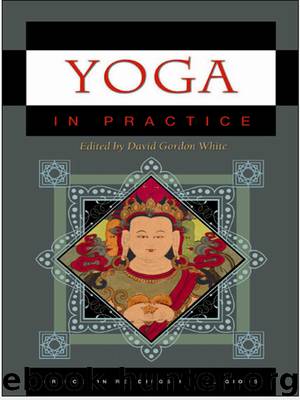Yoga in Practice by David Gordon White

Author:David Gordon White
Language: eng
Format: epub
Publisher: Princeton University Press
— 11 —
The Six-Phased Yoga of the Abbreviated Wheel of Time Tantra (Laghuklacakratantra) according to Vajrapi
Vesna A. Wallace
The text translated here is an excerpt taken from the Summary of the Ultimate Reality (Paramrthasagraha) commentary on the Condensed Instruction on Initiation (Sekoddea), an Indian text belonging to the literary corpus of the Wheel of Time Tantra (Klacakratantra). The commentary was composed by nrop, the tenth- to eleventh-century Indian bearer of the Klacakra tantric tradition. The excerpt included here contains a brief presentation of six-phased yoga as taught by the Indian master Vajrapni, who made use of several canonical sources for this presentation—particularly, the Tantra of the Esoteric Community (Guhyasamjatantra), kins’ Vajra Cage Tantra (kinvaj-rapañjara tantra), Net of Illusions Tantra (Myjlatantra), Litany of the Names of Mañjur (Mañjurnmasangti), and the abbreviated Wheel of Time Tantra. All of these sources share certain commonalities, and are relevant for understandinging six-phased yoga in the context of the Unexcelled Yoga Tantras.
Six-phased yoga can be found in various Indic traditions. In the Buddhist esoteric context, the practice of six-phased yoga marks the most advanced stage in the path of the Unexcelled (anuttara) Yoga Tantras, which is invariably considered as “the stage of completion,” the final stage of Tantric practice. As such, it is believed to lead directly to the attainment of supreme and complete awakening (samyaksabodhi), also referred to as the highest supramundane accomplishment (parama-lokottara-siddhi). Although six-phased yoga is common to all of the Unexcelled Yoga Tantras, the content of the individual phases varies slightly from one Tantra to another.
Vajrapi begins his exposition by providing a brief definition for each of the six successive phases of this yoga, known under the names of retraction (pratyhra), meditative stabilization (dhyna), breath control (pryma), retention (dhra), recollection (anusmti), and samdhi. He further offers a condensed teaching on the repeated cultivation of six-phased yoga as practiced in the Esoteric Community Tantra and the kins’ Vajra Cage Tantra. He also explains the hidden meanings of Buddhist Tantric terms as they are related to the four types of successive sdhana practices of six-phased yoga, referred to as (1) worship (sev), which is a preliminary to the retraction and meditative stabilization phases of six-phased yoga; (2) subsidiary contemplative practice (upasdhana), which is related to the practices of breath control and retention; (3) contemplative practice (sdhana), which is related to the practice of the recollection phase; and (4) sublime contemplative practice (mahsdhana), which is relevant for the final phase of the six-phased yoga, namely, the practice of meditative concentration on emptiness. Visualization practices that are a part of the stage of completion are a preparatory phase for the actual practice of six-phased yoga. Through them, the yogi trains his mind in perceiving the triple world—the worlds of desire, form, and formlessness that constitute cyclic existence—and his own body, speech, and mind as manifestations of the indivisible body, speech, and mind vajras of the Buddha. The unhindered and indestructible capacities of the Buddha’s body, speech, and mind that are mutually pervasive are here referred to as
Download
This site does not store any files on its server. We only index and link to content provided by other sites. Please contact the content providers to delete copyright contents if any and email us, we'll remove relevant links or contents immediately.
More Language of Letting Go: 366 New Daily Meditations by Melody Beattie(2860)
The Holy Spirit by Billy Graham(2783)
The Secret Power of Speaking God's Word by Joyce Meyer(2763)
To Light a Sacred Flame by Silver RavenWolf(2684)
Tuesdays With Morrie by Mitch Albom(2582)
The Lost Art of Good Conversation by Sakyong Mipham(2447)
The Traveler's Gift by Andy Andrews(2308)
Kundalini by Gopi Krishna(2094)
A Kingsbury Collection by Karen Kingsbury(2012)
Finding Chika by Mitch Albom(1887)
Angels of God: The Bible, the Church and the Heavenly Hosts by Mike Aquilina(1872)
Angels by Billy Graham(1846)
As a Man Thinketh by James Allen(1826)
Curse Tablets and Binding Spells from the Ancient World by Gager John G.;(1773)
The Yoga of Jesus: Understanding the Hidden Teachings of the Gospels by Paramahansa Yogananda(1757)
Autobiography of a Yogi (Complete Edition) by Yogananda Paramahansa(1743)
Barking to the Choir by Gregory Boyle(1734)
Anxious for Nothing by Max Lucado(1728)
How To Be Born Again by Billy Graham(1675)
